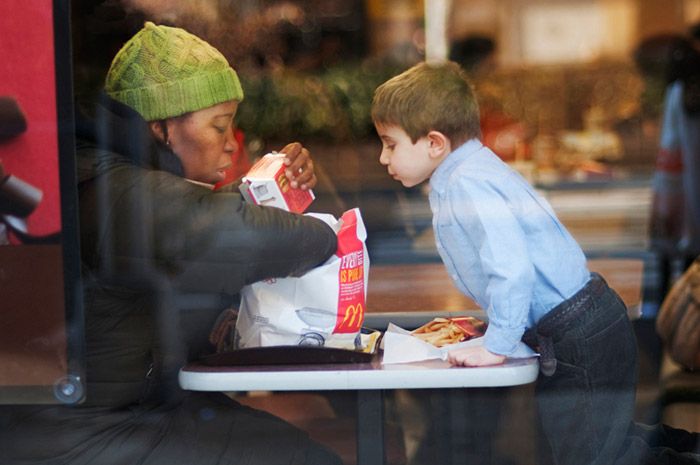blog
Interview with photographer Ellen Jacob
F-Stop Magazine: How did you first become involved in photography and what led to you working in this medium as an artist?
Ellen Jacob: When I was 12, I traveled cross-country with my Kodak instamatic. When I returned home, my mother said, “Your pictures are better than anyone your age.” Given that competitive encouragement, my love of images and art was solidified. I spent my Pratt years as a sculpture major, using photography to document my space and performance pieces.
About six years ago I picked up my camera again to explore issues that I feel deeply about. I try to use photography to explore the social and personal issues that concern and terrify me. These issues tend to be ones that are in front of us, but often not seen.
F-Stop: The “Documentary” issue of F-Stop includes your project “Substitutes,” can you tell us about this project? What led to you creating this project?
EJ: I live on Manhattan’s Upper West Side. I noticed that the women pushing the strollers are almost always women of color and the children white. I wondered why and my wondering became this multi-year project.
For me, the situation raised issues of racism and exploitation. These issues can be complex, especially at a personal level, and the answers are not always completely clear. Most of the women, nannies and employers, say race doesn’t matter. But if race doesn’t matter, why these persistent racial divides?
When I was young, a wonderful woman named Martha took care of me; she was black and I am white. I haven’t seen Martha for over 30 years, but I remember her face vividly. Substitutes is about the indelible impressions these women leave, and the persistent questions they raise.
F-Stop: Having worked as a nanny for a long time myself, I find your assessment of the job very interesting. My experience was different from what you describe in your statement (being white, decently paid, the relationships with children and family were openly acknowledged and talked about and continued beyond the time period of the job, etc). Do you think that the issues you are talking about are more specific to the Upper West Side or to perhaps the wealthy?
EJ: I find this question interesting. I would ask what is decent pay? What are the benefits? Do you get health care? Are your employers paying into Social Security on your behalf?
The women in these photographs are substitute parents. Being a nanny is a low-paying job where love between the nanny and child is one of the anticipated but unspoken duties. This is an unusual expectation in a financial transaction, I think.
Your own experience as a nanny is not unique at all. Every nanny I spoke with loved her work and loved the child (or children) she cared for. Most felt like part of the family, and many stayed in touch once the child was old enough to no longer need a nanny.
I don’t think this situation is peculiar to the Upper West Side. The UWS of Manhattan is a culturally and economically diverse neighborhood where the politics are overwhelming left—a place where you usually find great sympathy for the problems of women, minorities and the poor. Also, by New York standards, the families I encountered are well off, but not rich people.
F-Stop: Can you discuss your process for making these images? How do you find your subjects? Do you get to know them to any degree?
EJ: I found the nannies in a variety of ways. Some of the nannies I knew from my building. Some of the nannies were friends of theses nannies, some were introduced to me by the mother and some I went up to on the street and told them about my project. I spent time, sometimes days, with some of the nannies. This way I was able to develop a more intimate relationship which allowed me to capture more of their feelings. One nanny I photographed in New Jersey when the family moved there. With others I spent much shorter periods of time.
I started out shooting traditional street photography where I just snapped women with strollers, but found many of the images to be redundant and not in-depth enough. I became interested in learning more and wanted to talk with the women.
F-Stop: What do you hope people see or feel or perhaps learn when they look at these photographs?
EJ: I must admit that the response has been surprising and wonderful. The work was on exhibit at Soho Photo Gallery on White St in New York. Slate interviewed me and interest really took off. Huffington Post, The Daily Mail and others ran interviews. WPIX and MSNBC interviewed me live. The issue is one many people hadn’t thought about and it clearly hit a nerve. Some of the most rewarding reactions have come from women who work as nannies. Many of these women told me they felt validated and “seen” by my work. They saw themselves in the images.
F-Stop: Do you have a favorite image in this series? If so, which one and why is it the image that speaks to you most?
EJ: No. All the images have wonderful stories in them and looking at them makes me smile as I remember these strong, lovely women. I have kept in contact with some of the nannies and families.
F-Stop: What are you working on now?
EJ: I am working on what I plan as a series of photographic installations titled Waiting Room. The first installation is images and words of a friend of mine who spent over a year in a nursing home dying of cancer. This work explores the waiting, the persistence and the places, largely separated from life, where we live while dying.
F-Stop: What photographers or other artists inspire you?
EJ: It changes all the time. But right now I am inspired by Jim Goldberg, Sophie Calle and Cristina de Middel
F-Stop: What is the best career advice you have ever received?
EJ: Persist.
For more of Ellen Jacob’s work: www.ellenjacob.com
Location: Online Type: Featured Photographer, Interview
Events by Location
Post Categories
Tags
- Abstract
- Alternative process
- Architecture
- Artist Talk
- Biennial
- Black and White
- Book Fair
- Car culture
- charity
- Childhood
- Children
- Cities
- Collaboration
- Cyanotype
- Documentary
- environment
- Event
- Exhibition
- Family
- Fashion
- Festival
- Film Review
- Food
- Friendship
- FStop20th
- Gun Culture
- Italy
- journal
- Landscapes
- Lecture
- love
- Masculinity
- Mental Health
- Museums
- Music
- Nature
- Night
- photomontage
- Podcast
- Portraits
- Prairies
- River
- Still Life
- Street Photography
- Tourism
- UFO
- Wales
- Water
- Zine







Leave a Reply